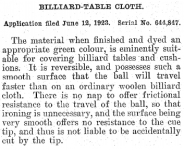Mr, Bond, which Mali family member is the person responsible for guiding Simonis into the pool cloth industry?
Henri Mali - born in Amsterdam in 1774 and went to Verviers to join forces with Simonis as managing partner of the company where he remained until his death in 1850. It was Henri Mali, who in 1799 found and arranged for John Cockerill, the inventor of the "Spinning Jenny," to come to Hamburg. Henri hired him and brought him to Verviers. This broke the English monopoly on the efficient manufacture of woven cloth.
In 1826, Henri sent his son, Henri Williem Theodore Mali, to look into the business situation in the United States. In that same year, he formed the Henry W. T. Mali & Co., Inc., and a few years later he was joined by his younger brother Charles Mali.
Since neither Henry W. T. or Charles had sons, their brother Jules Mali, then head of Simonis in Verviers, sent his eldest son, Pierre Mali, to New York in 1878 to carry on the family business. This tradition passed to John Taylor Johnston Mali, Pierre's eldest son, and then to Pierre's second son, Henry Julian Mali. Henry J.'s eldest son, Frederick Johnston Mali was the 5th generation to run Mali and Co.
I have some nice portraits too if you'd like to see one.
Interestingly enough, despite the fact that Mali was the exclusive importer of Simonis cloth, the Simonis company had also struck a deal with Brunswick to produce a special cloth exclusively for Brunswick alone. It was called "Super Weave" circa 1920
Last edited:
